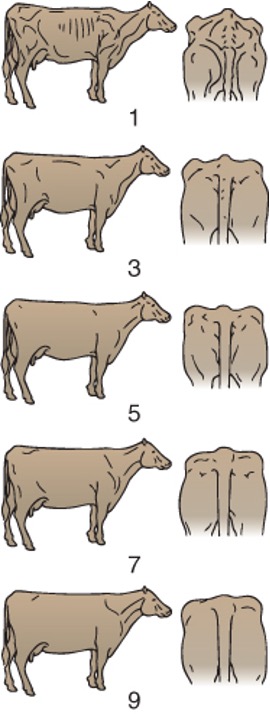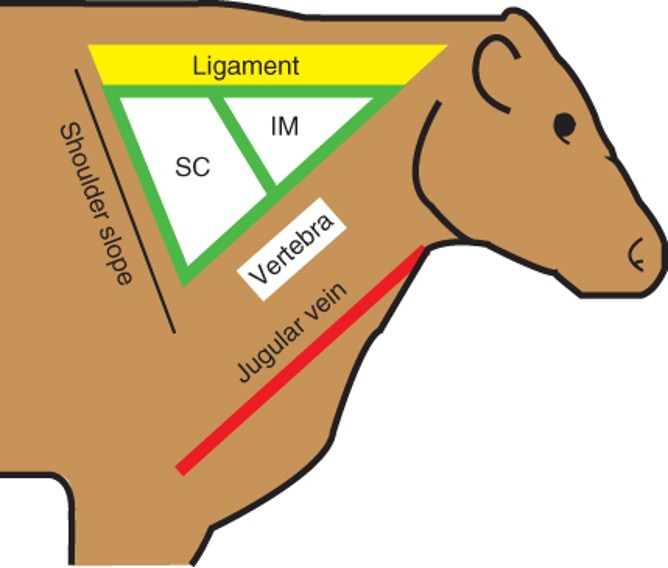Bovine Restraint, Physical Exam, and Sampling Techniques Vocabulary
1/46
Earn XP
Description and Tags
Flashcards on Bovine Restraint, Physical Exam, and Sampling Techniques
Name | Mastery | Learn | Test | Matching | Spaced |
|---|
No study sessions yet.
47 Terms
Heifer calf
Female neonate less than 1 year old.
Bull calf
Male neonate less than 1 year old.
Heifer
Female that has not given birth.
Cow
Mature female.
Bull
Mature male.
Steer
Castrated male.
Calving
The act of parturition, also known as freshening.
Dairy vs. Beef
Dairy breeds produce milk and are handled daily so most become acclimated to humans
Beef breeds produce beef and are only handled a few times per year so most are not acclimated to humans
Even if a cow or calf is docile or halter-broken, they are all very strong and can be very difficult to handle
Nose Leads (Snub)
A restraint method involving a clamp-like device around the nasal septum of cattle to control the head.
Tail Jack
A restraint method where the tail is used to help control movement.
A thorough history should not only involve the individual animal, but also the herd history
Herd size/use
Vaccination history/deworming history
Possible exposure to contagious diseases
Clinical signs-duration, severity, etc.
Medications given and when
Feeding regimen-how much, how often
Animal’s use (breeding stock, feeder calf, herd bull, etc.)
Cattle Physical Examination
Temperature
Pulse
Respiration
Heart/lung auscultation
Abdominal auscultation/palpation
Hydration status
Mucous membrane evaluation
+\- weight measurement (if scale)
Normal temperature for adult cattle
100-102.5oF
Heart Auscultation
Process of listening to the sounds of the heart.
Normal pulse/Heart rate for adult cattle
40-80 bpm
Pulse
Taken at the facial artery, transverse facial artery, coccygeal artery, or digital artery. Normal: 40-80 bpm
Lung Auscultation
Process of listening to the sounds of the lungs.
Normal Respiratory Rate for cattle
10-30 bpm
Eructation
Normal process where methane gas and CO2 produced by fermentation of food is expelled.
Rumination (chewing their cud)
Regurgitate partially digested food, chewed and swallowed again.
Abdominal Auscultation
Anywhere along the abdominal wall can be ausculted. Normal rumen contractions are 1 or 2 per minute.
The flank is divided into four quadrants:
Upper left (paralumbar fossa)
Lower left
upper right (paralumbar fossa)
Lower right
Dehydration
Indicated by sunken eyes and dry mucous membranes.
Normal MM color is light pink
easiest to assess on inner surface of vagina or conjunctiva
Cattle dental formula
2(I 0/3 C 0/1 P 3/3 M 3/3) = 32 {upper/lower}
Upper Dental Pad
Replaces incisors

Body condition
Venous blood sampling
Can be done for herd screening or on individual animals for diagnosing metabolic or infectious diseases.
Jugular vein
Most common site for venipuncture in cattle.
Use 16-18 g x 1 ½” needle at 45 degree angle to the skin
Coccygeal vein (tail vein)
Ventral midline, proximal 1/3 of tail.
18-20 g x 1-1 1/2:” needle at 45 – 90 degree angle to the skin
hemal processes (arches)-
bony canals on ventral aspect of vertebrae to protect artery and vein
must go between arches/vertebrae to find vein
Subcutaneous abdominal vein (milk vein)
Paired on right and left ventrolateral body wall of thorax and abdomen.
Only use if necessary-use cranial ½ of vein Avoid if possible!!
FDA
Responsible for drug approval and for establishing withdrawal intervals for food animals.
Extra-label drug use
Some drugs are used off-label in food animals- no withdrawal on label.
Balling gun
Used to deliver capsules/bolus (large tablets).
Head restraint is essential
Nose should not be higher than head height to decrease risk of tracheal aspiration of medication
Drenching
Delivery of liquid oral medication into oral cavity of ruminants
Oral dose syringe or 60 cc catheter tip syringe are commonly used
Frick speculum
Metal tube- placed like balling gun over base of tongue.
Can be used to deliver bolus/liquids
Can be used to assist passage of stomach tube by orogastric intubation
Gastric intubation
Used to deliver large quantities of fluid and to relieve bloat.
Used to relieve bloat
Used to obtain sample of rumen fluid
Nasogastric intubation
possible in cattle but limits size of tube to pass because of small nostrils in cattle
Orogastric intubation
more frequently used method
Speculum placed in mouth
Lubricate the end of tube with water
Advance tube to pharynx –meet resistance-
When animal swallows, tube is advanced
Proper placement in esophagus should be confirmed before fluid is administered
Observe tube passing through esophagus
Palpate tube passing through esophagus
Smell rumen gas or see rumen fluid in tube
Administering injections
Keep all injections in front of the shoulder (less valuable meat). Never inject into rump!
Never inject more than 10 cc in one site
Injection sites should be at least 4 inches apart
Read the label
Follow label recommendations for storage
Use subcutaneous if possible
Change needles at least every 10 animals
Intravenous
jugular vein is best, for small volume of medication, the caudal auricular vein and coccygealvein may be used
Caution with coccygeal vein! The coccygeal artery runs close to this vein and if injection is given perivascularly, blood flow to the tail may be compromised-tail necrosis
SQ injections:
16-18 g needle, ½-3/4” long
Skin tented, go into skin at a 45-degree angle
IM injections
16-18 g needle, 1-1 ½” long
Go straight into muscle, perpendicular to side of neck
Cover area and massage after injection to prevent leakage out of skin
Lateral neck SQ or IM injections for cattle:
hands width ventral to nuchal ligament
hands width cranial to cranial border of scapula
hands width dorsal to cervical vertebrae

Modified Live Vaccines
Bacteria or viruses are not killed but modified to stimulate an immune response
Packaged in freeze-dried vial that must be mixed with diluent
Lose effectiveness approximately 1 hour after mixing
Must be used immediately and remainder is discarded
More sensitive to light and temperature changes
More sensitive to disinfectants and other products that can destroy the vaccine
Usually given in the muscle so that the virus can reproduce and reach the lymphatic system more easily
Killed vaccines
Contain a killed virus or bacterin. Generally, less immune response to killed vs. modified live vaccines
Most can be given SQ or IM (read label directions)
Euthanasia
IV injection of barbituric acid derivatives
IV injection of potassium chloride (KCl) in conjunction with general anesthesia
Penetrating captive bolt
The following euthanasia methods are considered conditionally acceptable
Gunshot
Electrocution
NOT cervical dislocation